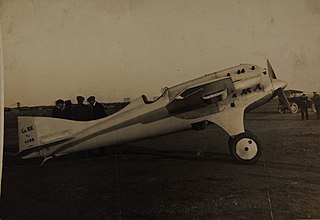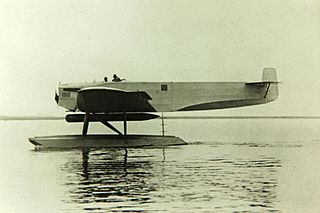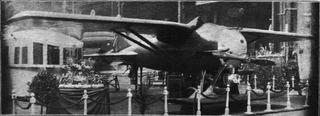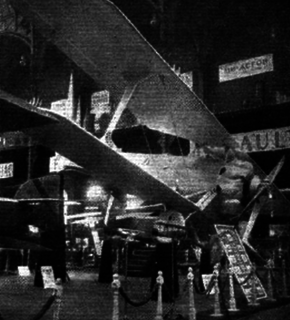Related Research Articles
The RAE Hurricane was a single-seat, single-engined light monoplane designed and built by the Aero Club of the Royal Aircraft Establishment for the 1923 Lympne Motor Glider Competition. It was underpowered with an unreliable engine. Re-engined, it flew in many races, with first place in the 1926 Grosvenor Challenge Cup its greatest success.
The Junkers J 29 was a two-seat, single-engined experimental training monoplane, built in Germany in 1925. Its significance is that it was the first aircraft to fly and test the Junkers Doppelflügel control surfaces used very successfully on the later Junkers Ju 52.
The Farman F.280 was a three engine, cantilever wing monoplane designed in France as a mail carrier in the early 1930s. Underpowered and slow, only two were built and briefly used.

The Arado Ar 77 was a German twin-engined monoplane, designed as an advanced training aircraft from 1934.
The Adolphe Bernard AB was a twin-engined French biplane aircraft, built near the end of the First World War. Ten AB 1 BN2 bombers were produced for the Armée de l'Air but did not reach squadron service; post-war, two civil derivatives were considered but only one aircraft was built.

The Bernard SIMB V.2 was a single-seat, single-engine French monoplane, built in the mid-1920s. It was originally designed for racing but was adapted for a successful attempt on the world absolute speed record.
The Bernard SIMB AB 10 was a French single-engine, single-seat, highly streamlined, cantilever, all-metal low-wing monoplane of advanced design. It first flew in 1924 but was not ordered into production.

The Bernard SIMB AB 12 was a French single engine, single-seat monoplane fighter aircraft built in the 1920s. Though advanced for its time, it failed to gain a production order and only one was built.

The Bernard 60 T and 61 T were closely similar, three engine, twelve seat passenger transports designed in France between 1929 and 1933. They were not a success and only one of each was built.
The Bernard 80 GR was one of three types built by different French constructors in response to a government call for an aircraft capable of setting new long-distance records. A single engine monoplane with a crew of two, the 80 GR set an absolute record for flight over a closed circuit in April 1931, covering 8,960 km (5,569 mi). Modifications led to a new designation as the Bernard 81 GR but no more records were set despite several attempts.
The Bernard H 110 was a single engine, single seat monoplane floatplane fighter designed for a French Navy competition. It flew in 1935 but had only made four test flights when the Bernard company was declared bankrupt, preventing further development.
The Bernard 260 C1 was a French all-metal, single-engine, low-wing monoplane with an open cockpit and fixed undercarriage, designed to a government single-seat fighter specification issued in 1930. After extensive comparative tests the Dewoitine D.500 was ordered in preference, though the performances of the two aircraft were similar.

The Fokker T.III or T.3 was a single engine floatplane designed in the Netherlands in the early 1920s as a bomber or torpedo bomber.

The Nieuport-Delage NiD 37 was a single-engine, single-seat monoplane fighter aircraft and racer designed and built in France in the early 1920s. It had a small foreplane to bring the centre of pressure forward. Heavy, slower than expected and with turbo-supercharger problems, development ended without any entering service.

The Hanriot H.31 was a single engine, single seat French biplane fighter aircraft built in 1925 to compete in a government programme. It was not successful and only one prototype was completed.
The Chasle YC-10 Migrateur was a single seat sports aircraft built in France in the early 1980s. Only one was built and it flew for less than 30 hours.

The Schneider Sch.10M was an all-metal, twin-boom, twin-engine French aircraft from the mid-1920s, intended as a bomber and with strong defensive armament. Only one was built.

The Caproni Ca.95 was a large, three engine, long range, heavy bomber prototype built in Italy in 1929. It could carry a 1,600 kg (3,500 lb) bomb load and had three defensive gun positions. Only one was built.
The unsuccessful French Farman F.200 of 1923 shared its type name with the 1929 Farman F.200, the progenitor of a series of parasol wing tourers. It was a two-seat touring aircraft, with a low, thick, cantilever wing. Only one was built and only briefly tested.
The Blériot 117 or B-117 was a large, twin-engined French aircraft from the mid-1920s. Heavily armed with three gun positions, it was designed to defend bomber formations against fighter attack. It did not reach production but was developed into the more successful Blériot 127.